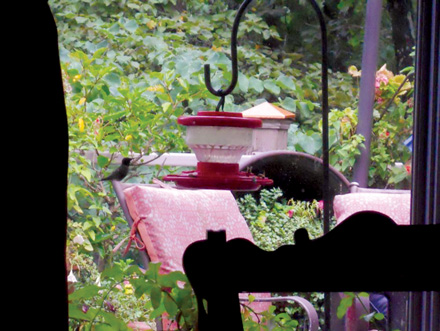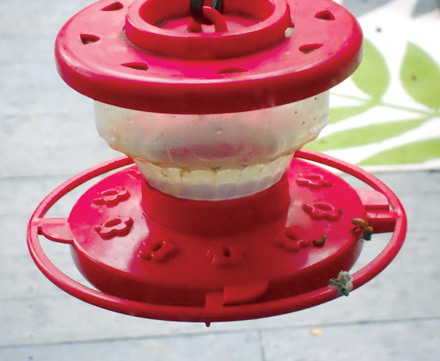Bees v. Hummers

I have been starting my mornings watching hummingbirds fending bees off a feeder hanging outside my den window. It started several weeks ago, as did the emails about bees visiting swimming pools as well as hummingbird feeders.
At this point in the season, honeybee colonies are at their highest population levels. Bees will fly between two to four miles from their hive looking for food. With record hot temperatures over 90F for several days, plants shut down pollen production leaving bees scrounging for food. Although many colonies have a nice stash of saved honey by now, some will turn to eating their stores if they can’t find other food sources.
There is a bit of a respite when we have rain. Some rains give plants a boost and plants start producing pollen again. Several days of record hot temperatures once again shuts the plants pollen production down, leading bees to look for food in all of the wrong places – hummingbird feeders in particular.
One of the recommendations I have read is to make sure your feeders don’t have anything yellow. The yellow color attracts bees. If you have hummingbird feeders with yellow flowers, gently pop them out for now. Hummingbirds can still get to the syrup with their long tongues.
Of all of the techniques people have suggested, the only one I know that works is feeding bees away from hummingbird feeders. To do, take a plant saucer, or use a birdbath. Add rocks and twigs, then sugar syrup made of two parts water to one part sugar. This is twice the concentration of hummingbird syrup, which is four parts water to one part sugar.
Use hot water to dissolve the sugar; then allow it to cool before feeding for both bees and hummingbirds.
Place the bee feeder away from the hummingbird feeders. You may need to initially place it close to the hummingbird feeders to get the bees attention but once you have buzzing visitors, move it away from bird feeders. Bees will share the new location with their sisters and stay away from the hummingbird feeders as long as you keep the thicker sugar syrup served.
Bees visit swimming pools, water faucets, hoses and other water sources this time of year because they need the moisture. They will carry water back to the hive to help keep it cool and to use it in mixing pollen and honey.
Frankly this active bee stage doesn’t last long. Worker bees only live for six weeks over summer, dying after they wear their wings to shreds. Hot weather tends to shut down the queen laying so colony numbers will soon start to decline as they get ready for winter.
Hummingbirds, meanwhile, traditionally migrate back to central and South America by mid-September so by the beginning of fall, all we have left to contend with are yellow jackets. These insects are the same size as honeybees but are ground nesters and repeatedly sting when provoked. Honeybees sting only once and then die.
Charlotte Ekker Wiggins is a beekeeper, gardener and sometimes cook. Published by El Dorado Springs Sun once in print and online with author’s permission. Copyright 2017, all rights reserved. This column may not be reprinted, republished or otherwise distributed without author’s permission. Contact Charlotte at gardeningcharlotte at gmail dot com.
 BEES LOOKING FOR ANY FOOD – Honeybees are attracted to hummingbird feeder syrup this time of year because they have few other sources of food.
BEES LOOKING FOR ANY FOOD – Honeybees are attracted to hummingbird feeder syrup this time of year because they have few other sources of food.

BEES HAVE SHORT REACH – One way to keep bees away from hummingbird feeders is to select hummingbird feeders with deep openings where bees can’t reach the sugar water. (Photos by Charlotte Ekker Wiggins).



Facebook Comments